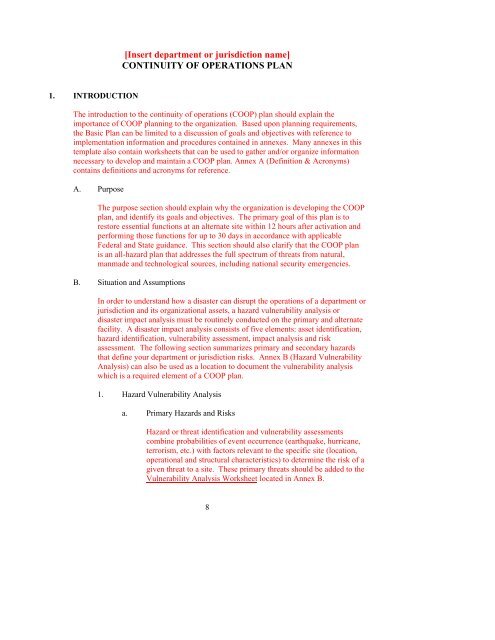CONTINUITY OF OPERATIONS PLAN TEMPLATE - Sedgwick County
CONTINUITY OF OPERATIONS PLAN TEMPLATE - Sedgwick County CONTINUITY OF OPERATIONS PLAN TEMPLATE - Sedgwick County
[Insert department or jurisdiction name]CONTINUITY OF OPERATIONS PLAN1. INTRODUCTIONThe introduction to the continuity of operations (COOP) plan should explain theimportance of COOP planning to the organization. Based upon planning requirements,the Basic Plan can be limited to a discussion of goals and objectives with reference toimplementation information and procedures contained in annexes. Many annexes in thistemplate also contain worksheets that can be used to gather and/or organize informationnecessary to develop and maintain a COOP plan. Annex A (Definition & Acronyms)contains definitions and acronyms for reference.A. PurposeThe purpose section should explain why the organization is developing the COOPplan, and identify its goals and objectives. The primary goal of this plan is torestore essential functions at an alternate site within 12 hours after activation andperforming those functions for up to 30 days in accordance with applicableFederal and State guidance. This section should also clarify that the COOP planis an all-hazard plan that addresses the full spectrum of threats from natural,manmade and technological sources, including national security emergencies.B. Situation and AssumptionsIn order to understand how a disaster can disrupt the operations of a department orjurisdiction and its organizational assets, a hazard vulnerability analysis ordisaster impact analysis must be routinely conducted on the primary and alternatefacility. A disaster impact analysis consists of five elements: asset identification,hazard identification, vulnerability assessment, impact analysis and riskassessment. The following section summarizes primary and secondary hazardsthat define your department or jurisdiction risks. Annex B (Hazard VulnerabilityAnalysis) can also be used as a location to document the vulnerability analysiswhich is a required element of a COOP plan.1. Hazard Vulnerability Analysisa. Primary Hazards and RisksHazard or threat identification and vulnerability assessmentscombine probabilities of event occurrence (earthquake, hurricane,terrorism, etc.) with factors relevant to the specific site (location,operational and structural characteristics) to determine the risk of agiven threat to a site. These primary threats should be added to theVulnerability Analysis Worksheet located in Annex B.8
- Page 1 and 2: BUSINESS NAMECONTINUITY OFOPERATION
- Page 3 and 4: RECORD OF CHANGESCHANGE DATE OF DAT
- Page 5 and 6: BUSINESS NAME[INSERT DEPARTMENT OR
- Page 7: 8. MULTI-YEAR STRATEGY AND PROGRAMM
- Page 11 and 12: B. Essential COOP PersonnelThe COOP
- Page 13 and 14: This section provides an overview o
- Page 15 and 16: warrant termination of the authorit
- Page 17 and 18: Annex M (Vital Equipment & System)
- Page 19 and 20: 5. COOP RESPONSBILITIESIn order for
- Page 21 and 22: Preparedness activities related to
- Page 23 and 24: Develop incident action plans to ac
- Page 25 and 26: COOP activities can also be address
- Page 27 and 28: A COOP exercise is a focused practi
- Page 29 and 30: designed distribution strategy will
- Page 31 and 32: J. CRITICAL CUSTOMERS: Organization
- Page 33 and 34: EE.FF.GG.HH.II.JJ.KK.LL.ORDERS OF S
- Page 35 and 36: equirement for an emergency managem
- Page 37 and 38: Severe weatherHazardous material in
- Page 39 and 40: TOTALbe considered a WEAK resource.
- Page 41 and 42: SECURITY ANALYSIS CHECKLISTAgency:
- Page 43 and 44: MITIGATION/PREVENTIONSPREADSHEETBas
- Page 45 and 46: Activation Readiness ChecklistThe f
- Page 47 and 48: CompletedNotRequired/ApplicableActi
- Page 49 and 50: ANNEX DALTERNATE FACILITYThis annex
- Page 51 and 52: COOP Planning WorksheetsWorksheet #
- Page 53 and 54: ANNEX ERELOCATION PLANThis annex sh
- Page 55 and 56: ESSENTIAL FUNCTIONS(PA CoG Workshee
- Page 57 and 58: Priority of Critical Processes & Se
[Insert department or jurisdiction name]<strong>CONTINUITY</strong> <strong>OF</strong> <strong>OPERATIONS</strong> <strong>PLAN</strong>1. INTRODUCTIONThe introduction to the continuity of operations (COOP) plan should explain theimportance of COOP planning to the organization. Based upon planning requirements,the Basic Plan can be limited to a discussion of goals and objectives with reference toimplementation information and procedures contained in annexes. Many annexes in thistemplate also contain worksheets that can be used to gather and/or organize informationnecessary to develop and maintain a COOP plan. Annex A (Definition & Acronyms)contains definitions and acronyms for reference.A. PurposeThe purpose section should explain why the organization is developing the COOPplan, and identify its goals and objectives. The primary goal of this plan is torestore essential functions at an alternate site within 12 hours after activation andperforming those functions for up to 30 days in accordance with applicableFederal and State guidance. This section should also clarify that the COOP planis an all-hazard plan that addresses the full spectrum of threats from natural,manmade and technological sources, including national security emergencies.B. Situation and AssumptionsIn order to understand how a disaster can disrupt the operations of a department orjurisdiction and its organizational assets, a hazard vulnerability analysis ordisaster impact analysis must be routinely conducted on the primary and alternatefacility. A disaster impact analysis consists of five elements: asset identification,hazard identification, vulnerability assessment, impact analysis and riskassessment. The following section summarizes primary and secondary hazardsthat define your department or jurisdiction risks. Annex B (Hazard VulnerabilityAnalysis) can also be used as a location to document the vulnerability analysiswhich is a required element of a COOP plan.1. Hazard Vulnerability Analysisa. Primary Hazards and RisksHazard or threat identification and vulnerability assessmentscombine probabilities of event occurrence (earthquake, hurricane,terrorism, etc.) with factors relevant to the specific site (location,operational and structural characteristics) to determine the risk of agiven threat to a site. These primary threats should be added to theVulnerability Analysis Worksheet located in Annex B.8



